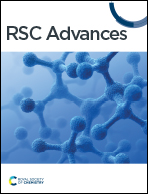Tyndall-effect-based colorimetric assay with colloidal silver nanoparticles for quantitative point-of-care detection of creatinine using a laser pointer pen and a smartphone†
Abstract
Herein, this paper initially reports a new colorimetric Tyndall effect-inspired assay (TEA) for simple, low-cost, sensitive, specific, and point-of-care detection of creatinine (an important small biomolecule) by making use of silver nanoparticles (AgNPs) as model colloidal nanoprobes for visual light scattering signaling. The naked-eye TEA method adopts negatively-charged citrate-capped AgNPs (Cit-AgNPs) prepared by sodium citrate reduction. In the presence of alkaline conditions, the creatinine analyte can form carbanion/oxoanion amino tautomers which in turn crosslink with carboxylate groups on the Cit-AgNPs via a hydrogen bonding network to mediate the aggregation of such colloidal nanoprobes showing a significantly-enhanced TE signal that was created and quantified by a hand-held laser pointer pen and a smartphone, respectively. The results demonstrate that the resulting equipment-free method with the TE readout could enable the portable quantification of creatinine with a detection limit of ∼55 nM, which was ∼90–2334 times lower than that obtained from AgNP-based colorimetric approaches with the most common localized surface plasma resonance signaling. Moreover, it shows a larger analytical sensitivity up to ∼580.8227 signal per nM, offering ∼2.4–232-fold improvement in comparison with many of the recent instrumental creatinine nanosensors. The accuracy and practicality of the developed nanosensing system was additionally confirmed with satisfactory recovery results ranging from ca. 98.52 to 100.36% when analyzing a set of real complex human urine samples.



 Please wait while we load your content...
Please wait while we load your content...